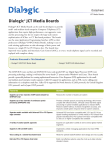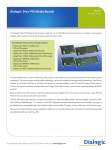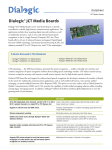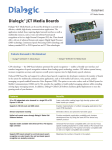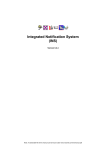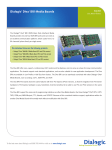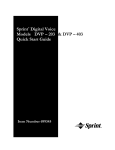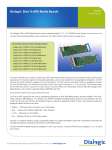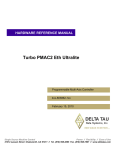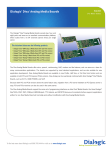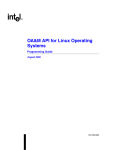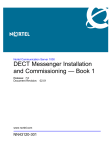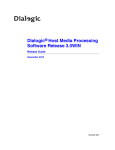Download Dialogic D/4PCIUF Combined Media Board
Transcript
Datasheet JCT Media Boards Dialogic® JCT Media Boards Dialogic® JCT Media Boards can be used by developers to provide small- and medium-sized enterprise Computer Telephony (CT) applications that require high-performance, cost-aggressive voice and fax processing, but do not require the large-scale system sophistication of SCbus- or CT Bus-based products. The boards use the same Application Programming Interface (API) as their predecessor (Dialogic® D/4PCI Media Board), making it easy to scale existing applications to take advantage of their power and features in a single PCI or PCI Express slot. The boards have improved voice quality and Automatic Gain Control (AGC), so even a weak telephone signal can be recorded and replayed with complete clarity. Products Discussed in This Datasheet • Dialogic® D/4PCIUF Media Board • Dialogic® D/4PCIU4S Media Board The D/4PCIUF (voice and fax) and D/4PCIU4S (voice and speech/CSP) use Digital Signal Processor (DSP) voice processing technology, making it well-suited for server-based CT systems under Windows® and Linux. These boards provide a powerful platform for creating sophisticated Interactive Voice Response (IVR) applications for the small- and medium-sized enterprise market segment. Caller ID support lets applications, such as IVR, receive calling party information via a telephone trunk line. Caller ID is supported for North America (CLASS protocol), the United Kingdom (CLI protocol), and in Japan (CLIP protocol). Features Benefits Supports up to four channels of DSP-based onboard fax (D/4PCIUF only) Reduces the number of boards per system Supports up to four channels of continuous speech processing (D/4PCIU4S only) Provides a flexible speech processing technology, which wnen coupled with efficient drivers, off-loads critical real-time signal processing in speech-enabled applications to onboard DSPs. Reduces system latency, increases recognition accuracy, and improves overall system response time for speech solutions. Separate models available with Universal PCI or PCI Express edge connector Universal PCI form factor compatible with 3.3 V and 5.0 V bus signals enabling deployment in a wide variety of PCI chassis from popular manufacturers; PCI Express form factor compatible with 1x slots (x1 or higher compatible) also available A variety of country-specific approvals Expands an application’s ability to serve several global market segments Supports G.726 and GSM coders Implements unified messaging applications that meet VPIM standards Voice coding on a channel-by-channel basis Allows for optimal tradeoff between disk storage and voice quality Half-size PCI or PCI Express form factor Build cost-effective systems using the most up-to-date industrystandard chassis Dialogic® JCT Media Boards Datasheet Technical Specifications Number of ports 4 Maximum boards per system 16 Analog network interface Onboard loop start interface circuits Control microprocessor Intel 80C186 @ 34.8MHz Digital signal processor Freescale DSP56303 @ 100 MHz, with 128Kx24 private Supported operating systems Windows®; Linux. Details at http://www.dialogic.com/systemreleases CSP Yes on D/4PCIU4S only Signaling Analog loop start Host Interface — PCI and PCI Express Bus compatibility PCI and PCI Express PCI bus speed 33 MHz maximum Shared memory 32 KB page Base addresses Selected by PCI or PCI Express BIOS Interrupt level 1 IRQ (IntA) shared by all boards Platform — PCI and PCI Express Form factor PCI Universal or PCI Express 6.9 in. (17.25 cm) long 0.75 in. (1.875 cm) wide 3.85 in. (9.625 cm) high (excluding edge connector) Power Requirements — PCI +5 VDC 650 mA Power Requirements — PCI Express +12 VDC 450 mA maximum Environmental Requirements — PC and PCI Express 2 Operating temperature +32°F (0°C) to +122F°F (+50°C) Storage temperature –4°F (–20°C) to +158°F (+70°C) Humidity 8% to 80% noncondensing Dialogic® JCT Media Boards Datasheet Technical Specifications (cont.) Telephone Interface Trunk type Loop start Ground start for inbound applications with AC ringing Impedance 600 Ohm (nominal). Matching complex impedance specified in TBR-21 for D/4PCIU-EURO Ring detection 15 Vrms min., 15 Hz to 68 Hz Loop current range 20 mA to 120 mA, DC (polarity insensitive) Crosstalk coupling –80 dB at 3 kHz channel-to-channel Connector 4 RJ-11 Approvals and Compliance Hazardous substances Safety and EMC Canada RoHS Compliance Information at http://www.dialogic.com/rohs/ ICES-003 Class A ULc CSA 60950-1 File E96804 Europe EN60950 EN55022 EN55024 Japan VCCI Class A United States FCC Part 15 Class A UL 60950-1 File E96804 International IEC60950-1 CISPR 22 CISPR 24 Telecom Approvals United States US:EBZKX07BD4PCIU Canada IC: 885A-D4PCIU European Union DoC Country-specific approvals See the Product Declarations & Global Approvals list at http://www.dialogic.com/declarations/ or contact your Authorized Distributor Reliability/Warranty Estimated MTBF Per Telecordia Method 1 Case 1 PCI: 434,000 hours PCI Express: 301,000 Warranty Warranty information at http://www.dialogic.com/warranties 3 Dialogic® JCT Media Boards Datasheet Springware/JCT Technical Specifications Facsimile (available on D/4PCIUF only) Fax compatibility ITU-T G3 compliant (T.4, T.30) ETSI NET/30 compliant Data rate 14,400 b/s (v.17) send 9600 b/s receive Variable speed selection Automatic step-down to 12,000 b/s, 9600 b/s, 7200 b/s, 4800 b/s, and lower Transmit data modes Modified Huffman (MH) Modified Read (MR) Receive data modes MH, MR File data formats Tagged Image File Format-Fax (TIFF-F) for transmit/receive MH and MR ASCII-to-fax conversion Host-PC-based conversion Direct transmission of text files All Windows® fonts supported Page headers generated automatically Error correction Detection, reporting, and correction of faulty scan lines Image widths 8.5 in. (21.5 cm) 10 in. (25.4 cm) 11.9 in. (30.23 cm) Image scaling Automatic horizontal and vertical scaling between page sizes Polling modes Normal Turnaround Image resolution Normal (203 pels/in. x 98 lines/in.; 203 pels/2.5 cm ? 98 lines/2.5 cm) Fine (203 pels/in. x 196 lines/in.; 203 pels/2.5 cm ? 196 lines/2.5 cm) Fill minimization Automatic fill bit insertion and stripping Audio Signal Receive range –50 dBm to –9 dBm (nominal), for average speech signals** configurable by parameter† Automatic gain control Application can enable/disable Above –30 dBm results in full scale recording, configurable by parameter† Silence detection –40 dBm nominal, software adjustable† Transmit level (weighted average) –9 dBm nominal, configurable by parameter† Transmit volume control 40 dB adjustment range, with application-definable increments, capped at legal limit Frequency Response 24 kb/s 300 Hz to 2600 Hz ±3 dB 32 kb/s 300 Hz to 3400 Hz ±3 dB 48 kb/s 300 Hz to 2600 Hz ±3 dB 64 kb/s 300 Hz to 3400 Hz ±3 dB Audio Digitizing 13 kb/s GSM @ 8 kHz sampling 24 kb/s ADPCM @ 6 kHz sampling 32 kb/s ADPCM @ 8 kHz sampling 32 kb/s G.726 @ 8 kHz sampling 48 kb/s µ-law PCM @ 6 kHz sampling 64 kb/s µ-law PCM @ 8 kHz sampling Digitization selection Selectable by application on function call-by-call basis Playback speed control Pitch controlled, available for 24 kb/s and 32 kb/s data rates Adjustment range: ±50% Adjustable through application or programmable DTMF control Wave Audio Record/Play 11 kHz linear PCM, 8-bit mono mode (available only when running Windows®) 4 Dialogic® JCT Media Boards Datasheet Springware/JCT Technical Specifications (cont.) DTMF Tone Detection DTMF digits 0 to 9, *, #, A, B, C, D per Telcordia LSSGR Sec 6 Dynamic range Programmable, default set at –45 dBm to –3 dBm per tone Minimum tone duration 40 ms, can be increased with software configuration Interdigit timing Detects like digits with a 40 ms interdigit delay Detects different digits with a 0 ms interdigit delay Twist and frequency variation Meets Telcordia LSSGR Sec 6 and EIA 464 requirements Acceptable twist 10 dB Signal/noise ratio 10 dB (referenced to lowest amplitude tone) Noise tolerance Meets Telcordia LSSGR Sec 6 and EIA 464 requirements for Gaussian, impulse, and power line noise tolerance Cut-through Detects down to –36 dBm per tone into 600 Ohm load impedance Talk-off Detects less than 20 digits while monitoring Telcordia TR-TSY-000763 standard speech tapes (LSSGR requirements specify detecting no more than 470 total digits) Detects 0 digits while monitoring MITEL speech tape #CM 7291 Global Tone Detection Tone type Programmable for single or dual Maximum number of tones Application dependent Frequency range Programmable within 300 Hz to 3500 Hz Maximum frequency deviation Programmable in 5 Hz increments Frequency resolution Less than 5 Hz Note: Certain limitations exist for dual tones closer than 60 Hz apart Timing Programmable cadence qualifier, in 10 ms increments Dynamic range Programmable, default set at –36 dBm to –3 dBm per tone Global Tone Generation Tone type Generate single or dual tones Frequency range Programmable within 200 Hz to 4000 Hz Frequency resolution 1 Hz Duration 10 ms increments Amplitude –43 dBm to –3 dBm per tone, programmable MF Signaling MF digits 0 to 9, KP, ST, ST1, ST2, ST3 per Telcordia LSSGR Sec 6, TR-NWT-000506 and ITU-T Q.321 Transmit level Complies with Telcordia LSSGR Sec 6, TR-NWT-000506 Signaling mechanism Complies with Telcordia LSSGR Sec 6, TR-NWT-000506 Dynamic range for detection –25 dBm to –3 dBm per tone Acceptable twist 6 dB Acceptable freq. variation Less than ±1 Hz 5 Dialogic® JCT Media Boards Datasheet Springware/JCT Technical Specifications (cont.) Call Progress Analysis Busy tone detection Default setting designed to detect 74 out of 76 unique busy/congestion tones used in 97 countries as specified by ITU-T Rec. E., Suppl. #2 Default uses both frequency and cadence detection Application can select frequency only for faster detection in specific environments Ring back detection Default setting designed to detect 83 out of 87 unique ring back tones used in 96 countries as specified by ITU-T Rec. E., Suppl. #2 Uses both frequency and cadence detection Positive voice detection accuracy >98% based on tests on a database of real-world calls Positive voice detection speed Detects voice in as little as 1/10th of a second Positive answering machine detection accuracy Standard Fax/modem detection Preprogrammed Intercept detection Detects entire sequence of the North American tri-tone Other SIT sequences can be programmed Dial tone detection before dialing Application enable/disable Supports up to three different user-definable dial tones Programmable dial tone dropout debouncing Tone Dialing DTMF digits 0 to 9, *, #, A, B, C, D; 16 digits per Telcordia LSSGR Sec 6, TR-NWT-000506 MF digits 0 to 9, KP, ST, ST1, ST2, ST3 Frequency variation ±0.5% of nominal frequency Rate 10 digits/s max., configurable by parameter† Level –5 dBm per tone, nominal, configurable by parameter† Pulse Dialing 10 digits 0 to 9 Pulsing rate 10 pulses/s, nominal; 20 pulses/s for Japan configurable by parameter† Break ratio 60% nominal, configurable by parameter† Analog Caller Identification Applicable standards Telcordia TR-TSY-000030 Telcordia TR-TSY-000031 TAS T5 PSTN1 ACLIP: 1994 (Singapore) British Telecom SIN 242 (Issue 01) British Telecom SIN 227 (Issue 01) Japan NTT CLIP Modem standard Bell 202 or V.23, serial 1200 b/s (simplex FSK signaling) Receive sensitivity –48 dBm to –1 dBm Noise tolerance Minimum 18 dB SNR over 0 dBm to –48 dBm dynamic range for error-free performance Data formats Single Data Message (SDM) and Multiple Data Message (MDM) formats via API calls and commands Impedance 600 Ohm for D/PCIUF Matching complex impedance specified in TBR-21 for D/4PCIUF-EURO. Message formats ASCII or binary SDM, MDM message content Analog Display Services Interface (ADSI) FSK generation per Telcordia TR-NWT-000030 CAS tone generation and DTMF detection per Telcordia TR-NWT-001273 6 Dialogic® JCT Media Boards Datasheet Hardware System Requirements Pentium processor or compatible computer. Operating system hardware requirements vary according to the number of channels being used. Ordering Information Product Code Order Code Description D4PCIUFW 881-775 4-port Analog, Loop-Start, PCI D4PCIU4SW 881-703 4-port Analog, Loop-Start, PCI D4PCIUFWEU 881-803 4-port Analog, Loop-Start, PCI, Europe D4PCIU4SWEU 881-773 4-port Analog, Loop-Start, PCI, Europe D4PCIUFEW 887-440 4-port Analog, Loop-Start, PCIe D4PCIU4SEW 887-497 4-port Analog, Loop-Start, PCIe D4PCIUFEWEU 887-437 4-port Analog, Loop-Start, PCIe, Europe D4PCIU4SEWEU 887-494 4-port Analog, Loop-Start, PCIe, Europe 7 To learn more, visit our site on the World Wide Web at http://www.dialogic.com Dialogic Corporation 9800 Cavendish Blvd., 5th floor Montreal, Quebec CANADA H4M 2V9 INFORMATION IN THIS DOCUMENT IS PROVIDED IN CONNECTION WITH PRODUCTS OF DIALOGIC CORPORATION (“DIALOGIC”). NO LICENSE, EXPRESS OR IMPLIED, BY ESTOPPEL OR OTHERWISE, TO ANY INTELLECTUAL PROPERTY RIGHTS IS GRANTED BY THIS DOCUMENT. EXCEPT AS PROVIDED IN A SIGNED AGREEMENT BETWEEN YOU AND DIALOGIC, DIALOGIC ASSUMES NO LIABILITY WHATSOEVER, AND DIALOGIC DISCLAIMS ANY EXPRESS OR IMPLIED WARRANTY, RELATING TO SALE AND/OR USE OF DIALOGIC® PRODUCTS INCLUDING LIABILITY OR WARRANTIES RELATING TO FITNESS FOR A PARTICULAR PURPOSE, MERCHANTABILITY, OR INFRINGEMENT OF ANY INTELLECTUAL PROPERTY RIGHT OF A THIRD PARTY. Dialogic products are not intended for use in medical, life saving, life sustaining, critical control or safety systems, or in nuclear facility applications. Dialogic may make changes to specifications, product descriptions, and plans at any time, without notice. Dialogic is a registered trademark of Dialogic Corporation. Dialogic's trademarks may be used publicly only with permission from Dialogic. Such permission may only be granted by Dialogic’s legal department located at the address given above. Any authorized use of Dialogic's trademarks will be subject to full respect of the trademark guidelines published by Dialogic from time to time and any use of Dialogic’s trademarks requires proper acknowledgement. Windows is a registered trademark of the Microsoft Corporation in the United States and/or other countries. Other names of actual companies and products mentioned herein are the trademarks of their respective owners. Dialogic encourages all users of its products to procure all necessary intellectual property licenses required to implement their concepts or applications, which licenses may vary from country to country. None of the information provided in this datasheet other than what is listed under the section entitled Technical Specifications forms part of the specifications of the product and any benefits specified are not guaranteed. Positive Answering Machine Detection/Positive Voice Detection These performance results were measured using specific computer systems and/or components within specific lab environments and under specific system configurations. Any difference in system hardware, software design, or configuration may affect actual performance. The results are furnished for informational use only and should not be construed as a commitment by Dialogic. Dialogic assumes no responsibility or liability for any errors or inaccuracies. Outbound Dialing/Telemarketing Outbound dialing systems may be subject to certain laws or regulations. Dialogic makes no representation that Dialogic products will satisfy the requirements of any such laws or regulations (including, without limitation, any regulations dealing with telemarketing). ** Average speech mandates +16 dB peaks above average and preserves –13 dB valleys below average. † Analog levels: 0 dBm0 corresponds to a level of +3 dBm at tip-ring analog point. Values vary depending on country requirements; contact your Dialogic Sales Engineer. Copyright © 2007 Dialogic Corporation All rights reserved. 10/07 www.dialogic.com 8497-07








